Foreign Insulators
by Marilyn Albers
Reprinted from "Crown Jewels of the Wire", December 1989, page 16
AN INSULATOR -- LIGHTS UP MY LIFE
Look what I brought home from the recent Show in Bakersfield, California,
October 14-15! An insulator forms the base of this lamp -- a clear CD 518 with
the numbers "5119" embossed on the skirt and the letters
"SP" encircled within a tiny 5 point star plus the date
"1966" on the base rim. There is no inner skirt to disguise the
wiring, so the lamp maker chose to treat the inside of the insulator with some
sort of acid to give it a frosty appearance. Other than the fact that holes had
to be drilled into such a beautiful piece of glass, it didn't bother me one bit
to buy this lamp from Jack Foote (Sacramento, CA) if that's what it took to add
a new embossing to my collection of Italian insulators. I shall enjoy it
immensely! Jack said he found it at a flea market and that the dealer also had
some lamps made from other insulators, but the CD 518 was the one that really
caught his eye.
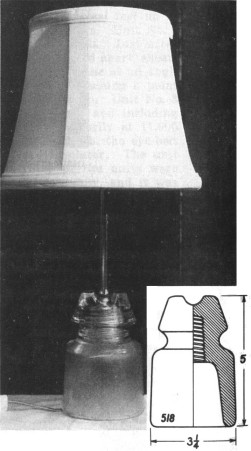
Table lamp made with a CD 518 glass insulator
There's a question on your lips. Can I attribute this embossing
to a particular manufacturer? No, not yet, but I do know that the letters
"SP" within a star have been found embossed on the base rim of a CD
516 owned by Jarl Anderson of East Freetown, Massachusetts, and also on a
similar piece in the collection of Bill Snell of Rochester, New York. Both of these insulators are
Italian. And, of course, the real teaser is knowing that an identical star with
the letters "FV" (see next page for illustration) is the trademark
used on bottles
made by FIDENZA S.A. VETRARIA, or Fidenza Glass Factory, Inc. of Milan. We've
seen the word "FIDENZA" embossed on Italian insulators, so it is
possible that the "SP" variation of the star logo on some insulator
specimens indicates that they are a product of the Fidenza Glass Factory, or at
least a division of it. Don't quote me, because a bad guess is not always better
than no guess!

FIDENZA SA. VETRARIA MILANO

Logo on CD 518
THESE TWO NEW CD's AREN'T TALKING
The two high power insulators pictured are completely unembossed. Not even a
whisker! Both are made of yellow tinted glass which is quite similar in
appearance to Pyrex glass, which they could very well be. But Woody, our expert
on glass insulators, has determined that neither one of them is of American
manufacture. However, Corning Glass Works did grant licenses to make Pyrex
glass to glass manufacturers in England and France starting in 1922. And it is
reported that there is one in South America, perhaps Brazil. And we know for
certain that Pyrex insulators were made in Italy because we have located a glass
dry spot (CD 402 at right) in this same color of glass that is embossed Pyrex on
one side and MIVA on the other, definitely an Italian marking.
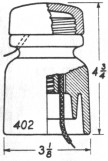
CD 624 (pictured on next page) belongs to Tony Longtin of Champlain, New
York. It measures 7-7/8" across the base and is 4-3/8" tall. Just a
beautiful piece of glass! Tony got it from a collector right here in the States,
but has no information about its origin.
CD 322.5 (pictured on next page) belongs to the author of this column. The
only things that set it apart from our familiar CD 323 Pyrex 271 are the slight
variations in measurement (CD 323 is 7-1/2" x 5-1/2" and CD 322.5 is 6-7/8" x 5-3/4") and those "foreign" ears! Can't tell you
anything else except that Tony and I are enjoying these insulators. Can any
of our readers identify them?
ON THE BELGIUM SCENE
Dale Huber is from Colfax, California, but his "fairy godmother"
must live in Belgium because she has been finding him some amazing glass! The
little "weejun" shown (bottom of next page) is nearly minus a
petticoat, but there was enough of it left to get measurements and a good shadow
profile. We have dubbed it our new CD 504. It's a mere 2-1/2" tall and has
a base diameter of 1-3/4" The color of glass is aqua and the embossing reads "VERLICA BELGIUM/BT 11". Cute!

New CD 624

New CD 322.5
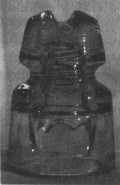
CD 504
In the photo which follows on the next page, you will see three CD 585
"twist lock" insulators. These are such interesting pieces because of
the color variation, as well as the fact that they are tiny (2-3/8" x
3"), intricate and fragile. It's hard to settle for just one.
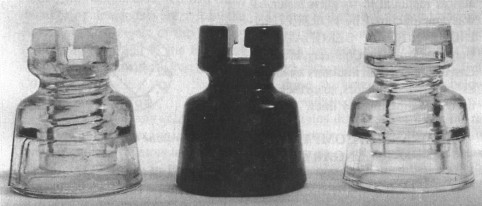
Three CD 585 "twist-lock" insulators from Belgium. Embossings read:
Left - VERHAM-ELAF/BT 61, light green
Center - VERLICA-ELAF/BT 61, dark emerald
green
Right - VERLICA-ELAF/BT 61, aqua

FOUND A BIG'UN!
Take a look at the insulator on the left in the photo above. Talk about a
hunk! This glass beauty from West Germany has just recently come to light and
has been classified as CD 449. It's of aqua glass, measures 3-5/8" across
the base and 5" in height. Embossing is simply VEGLA, which is for VEREINIGTE-GLASWERKE, or United Glass Works, a manufacturer which has (or had)
plants in the cities of Stoberg, Herzogenrath, Mannheim and Sindorf.
A friend of mine is in West Germany right now and is going to see if the
company is still in business. Hopefully, we can get an address and make
contact for further information.
The insulator on the right is U-1278, almost identical to its glass sister. It was manufactured by PORZELLAN-
INDUSTRIE AG BERGHAUS, or Berghaus Porcelain Company, in Auma, East Germany.
Both insulators are known as "railroad" insulators, since they were
used along the railway lines.
THE DRASCHE COMPANY OF PEST, HUNGARY
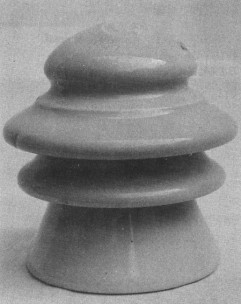
Mike Issler of Sparta, New Jersey, was the owner of the pretty little one
piece porcelain insulator you see in the photo above. It was eventually sent to
me for a drawing and possible U-number assignment. Several collectors had looked
at it but up to that point no one could make anything out of the round bump in
the crown. "Ho-hum, probably a marking, can't read it When I received it, I
put on two pairs of glasses, went out side with it into the sunshine and looked
at that marking under a magnifying glass. Finally, I was able to make out just
two words -- DRASCHE and BUDAPEST. The rest of it was lost in the glaze, but I didn't care. This alone
was exciting because I'd never seen the marking before, nor an insulator quite
like it. Incidentally, as I write, Jack Tod is scrutinizing the piece and will,
I'm sure, assign it a number. From the photo, you would never guess it is only 6
inches tall.

The Drasche Company Trademark
With a little help from my friend, who is head of lFO Electric in Vienna, I
am able to share with you the following information:
"In Hungary, the Foreign Trade Company
TRANSELEKTRO deals with the exports of low and high-voltage porcelain
insulators. Porcelain insulators are manufactured by two factories in the
country. Dating back to many decades, the enormous production experiences
accumulated by the two factories are well evidenced by years of foundation --
1852 and 1868, respectively. In the years after 1888, with the introduction of
telegraphy and telephony, the telephone overhead lines were constructed with
insulators of Hungarian make. And following the turn-of-the-century, the
production of high voltage porcelain insulators was also started to meet
contemporary requirements. In 1911, the first insulator testing and inspection station was established. At that time, the existing demands were met by the
porcelain departments of the Zsolnay Factory at Pecs, and of the Budapest Coal
Mining Brickworks of Pest (Drasche Co.)."
The Drasche Company is, apparently, no longer in business, or if it is, it no
longer supplies insulators for Hungary. The Zsolnay Factory in Pecs and another porcelain manufacturer in the city of Kobanya are now major suppliers
and are part of a larger group called FIM
PORZELLANFABRIK. The Zsolnay factory still uses its trademark on insulators, but
the Kobanya plant (which succeeded the Drasche Company) uses quite a different
one. Both of these markings are shown below, along with two typical European
insulator styles that bear the mark of the FIM plant in Kobanya. For some
history on the Zsolnay Factory, please refer back to the September, 1979, issue
of Crown Jewels, or send me an SASE and I'll mail you a Xerox copy of that article.
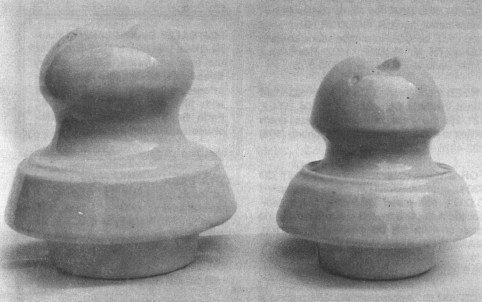
U-2290 (left) and U-2279 (right) are white porcelain insulators with the
mark
of FIM PORZELLANFABRIK, Kobanya plant.

FIM PORZELLANFABRIK
of KÖBÅNYA |

FIM PORZELLANFABRIK
of PEC.
This is also still known as Zsolnay. |
| 